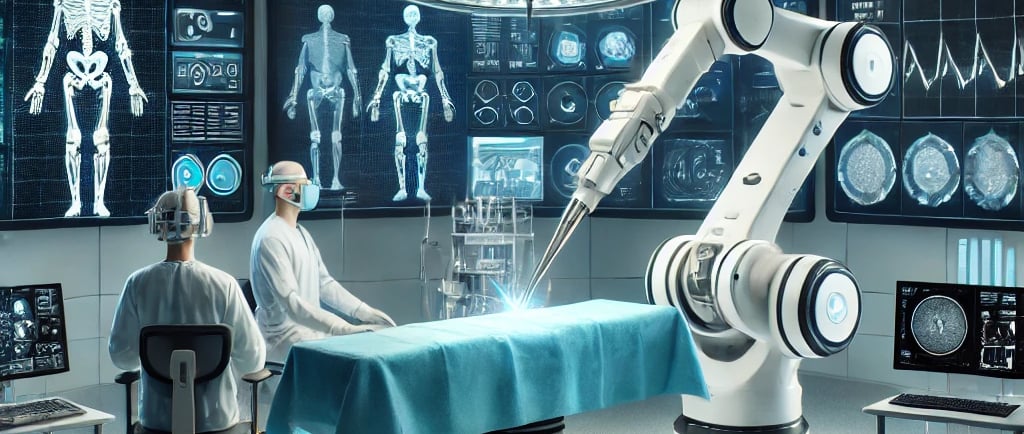The Future of Medical Equipment:
Blog post description.
3/17/20252 min read


The Future of Medical Equipment: Breaking News & Emerging Trends
The medical equipment and technology sector is evolving at an unprecedented pace, driven by innovation, regulatory shifts, and emerging healthcare needs. Keeping up with the latest advancements is crucial for healthcare professionals, industry stakeholders, and tech enthusiasts alike. Here’s a roundup of the latest breaking news and trends in medical equipment and technology that are shaping the future of healthcare.
1. AI and Robotics Revolutionizing Surgery
Artificial intelligence (AI) and robotic-assisted surgeries are making significant strides in improving precision and patient outcomes. AI-driven imaging systems can now assist in detecting anomalies with near-perfect accuracy, while robotic surgical systems, such as the Da Vinci Surgical System, enable minimally invasive procedures that reduce recovery times. New breakthroughs in autonomous robotic surgery are also expected to redefine operating room dynamics in the coming years.
2. Wearable Health Tech: The Rise of Smart Monitoring
Wearable technology is no longer limited to fitness tracking. The latest smart wearables are equipped with advanced sensors capable of monitoring heart rate variability, blood oxygen levels, glucose levels, and even early signs of diseases like atrial fibrillation. Companies like Apple, Fitbit, and Medtronic continue to push the boundaries with AI-driven diagnostics and remote patient monitoring solutions, improving accessibility and preventive care.
3. 3D Printing Transforming Prosthetics and Implants
3D printing is revolutionizing the way medical devices and implants are manufactured. Customized prosthetics, patient-specific implants, and even bioprinted tissues are making healthcare more personalized and effective. Researchers are now exploring the potential of 3D bioprinting to develop functional organ structures, which could someday address the global shortage of organ donors.
4. Telemedicine and Remote Healthcare Expansion
The COVID-19 pandemic accelerated the adoption of telemedicine, and it continues to grow. The integration of AI in telehealth platforms enhances virtual consultations with real-time diagnostics, making remote healthcare more efficient. Additionally, wearable devices and home-monitoring systems are allowing healthcare providers to track patient conditions remotely, reducing hospital readmissions and healthcare costs.
5. The Next Generation of Medical Imaging
Medical imaging technologies are advancing with the incorporation of AI and machine learning. AI-powered MRI and CT scans now assist radiologists in detecting diseases like cancer at earlier stages with higher accuracy. Additionally, new imaging techniques, such as photon-counting CT and molecular imaging, promise to enhance diagnostics and treatment planning for complex conditions.
6. Regulatory Updates Impacting Medical Tech
Regulatory bodies like the FDA and the European Medicines Agency are constantly updating guidelines to keep up with emerging medical technologies. Recent regulatory shifts focus on improving cybersecurity in connected medical devices, streamlining approval processes for AI-powered diagnostics, and enhancing patient data protection measures. Companies investing in compliance and regulatory foresight will be better positioned to navigate these evolving frameworks.
7. The Rise of Sustainable Medical Devices
Sustainability is becoming a critical focus in medical technology. Manufacturers are exploring eco-friendly materials, reusable medical devices, and energy-efficient equipment to reduce healthcare’s environmental footprint. Initiatives to recycle and refurbish medical devices are also gaining traction, aligning with the broader push toward greener healthcare solutions.
Final Thoughts
The landscape of medical equipment and technology is shifting rapidly, bringing transformative solutions to the healthcare industry. As AI, robotics, wearable tech, and sustainable innovations continue to reshape the market, staying informed is essential for professionals and consumers alike. By keeping up with these trends, we can anticipate the future of healthcare and embrace advancements that improve patient outcomes and operational efficiencies.
For more updates on medical technology trends, stay tuned to our blog. Your insights and discussions are welcome—let’s shape the future of healthcare together!
